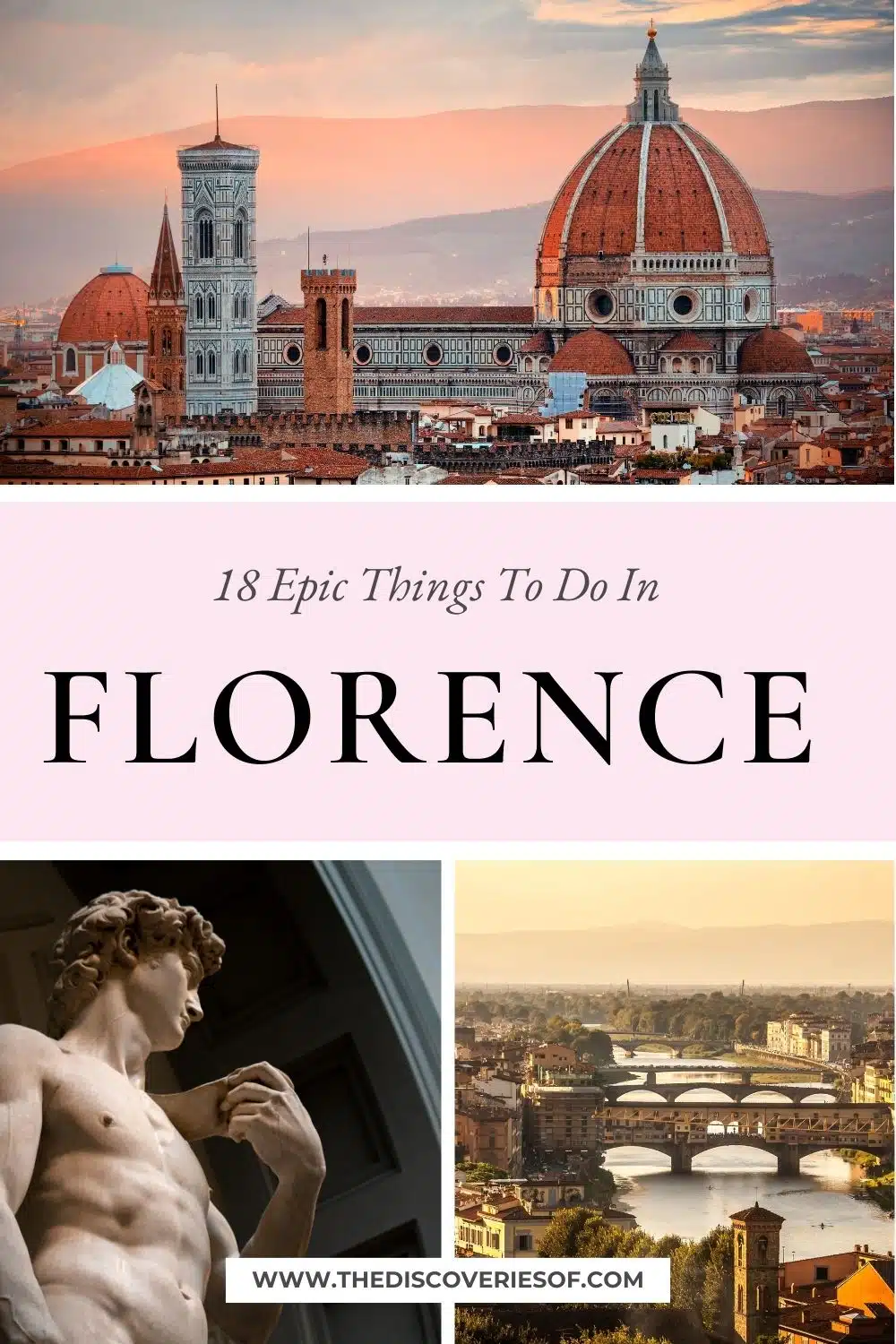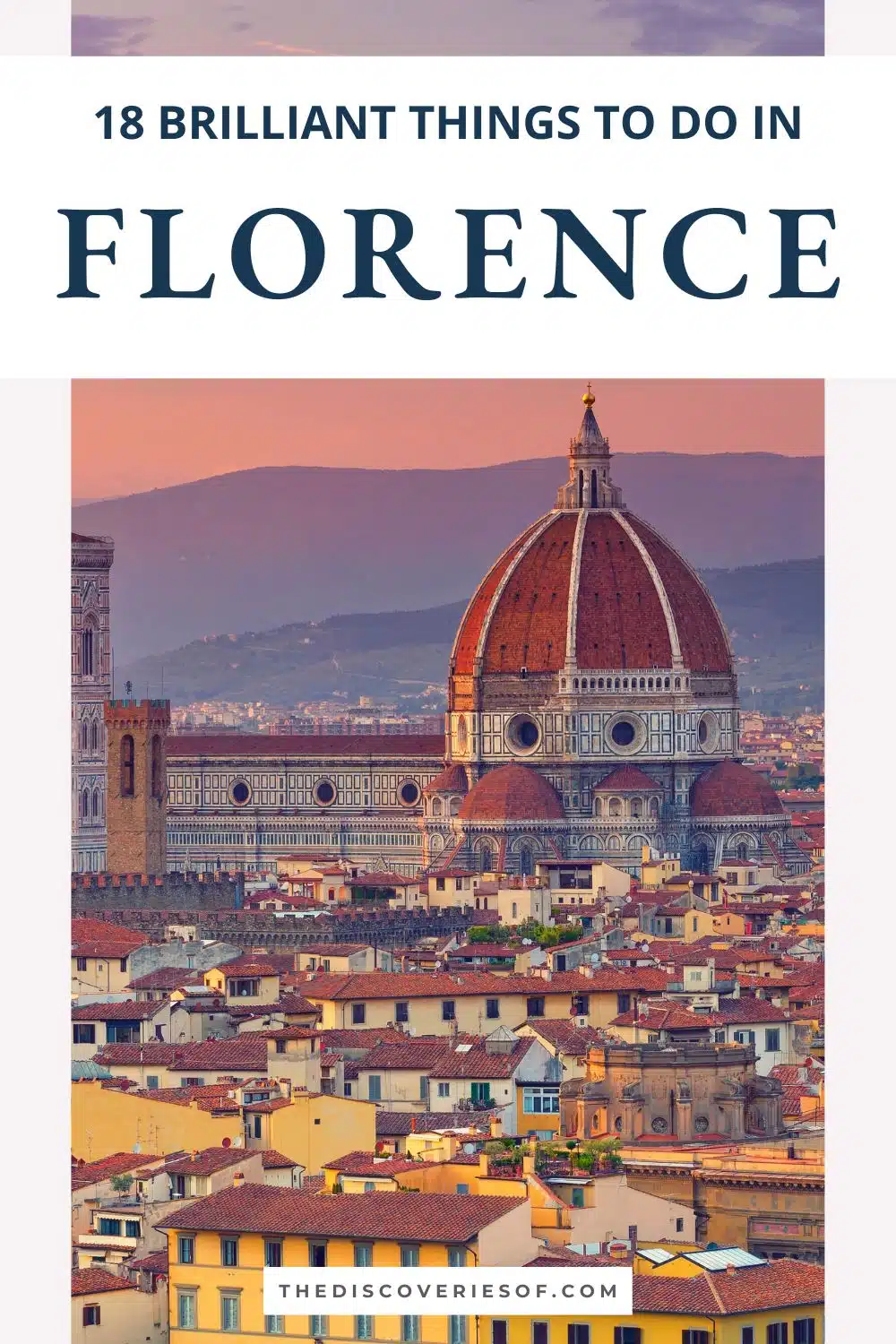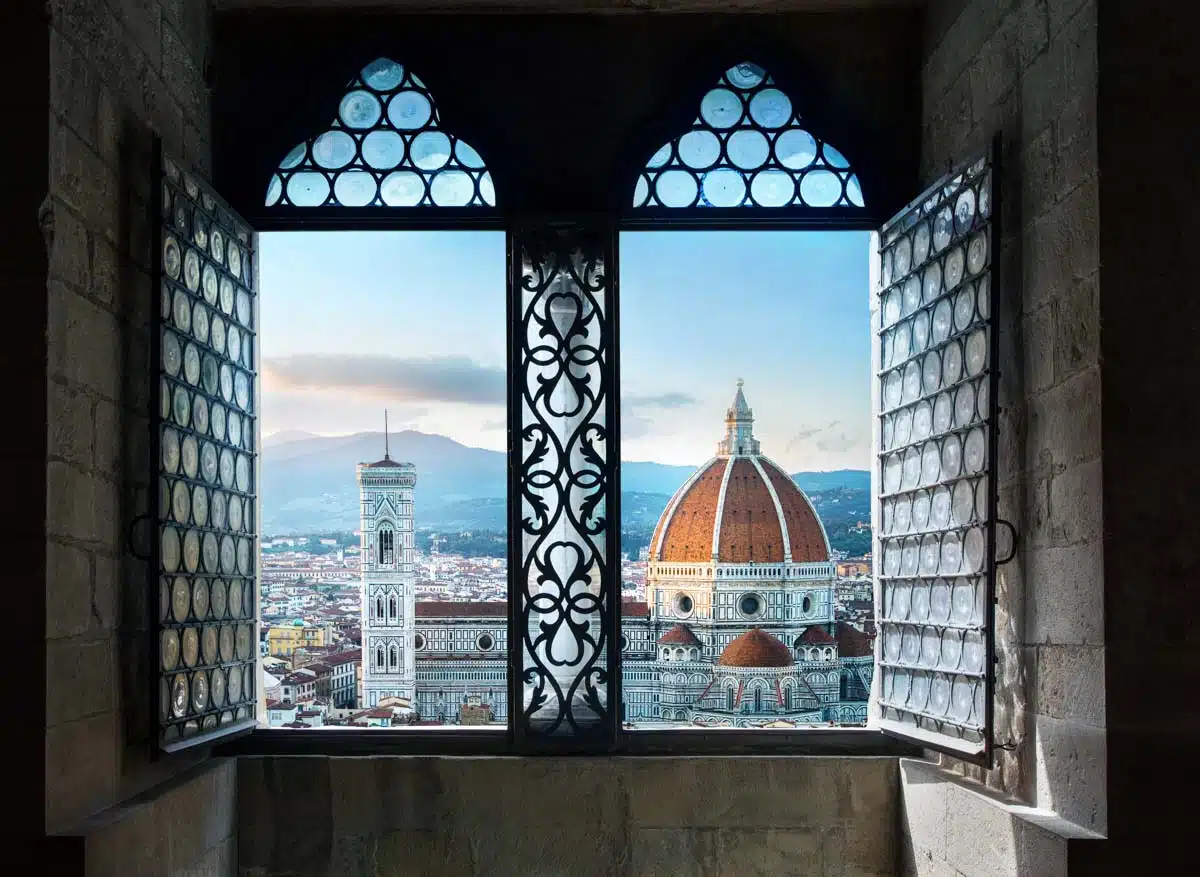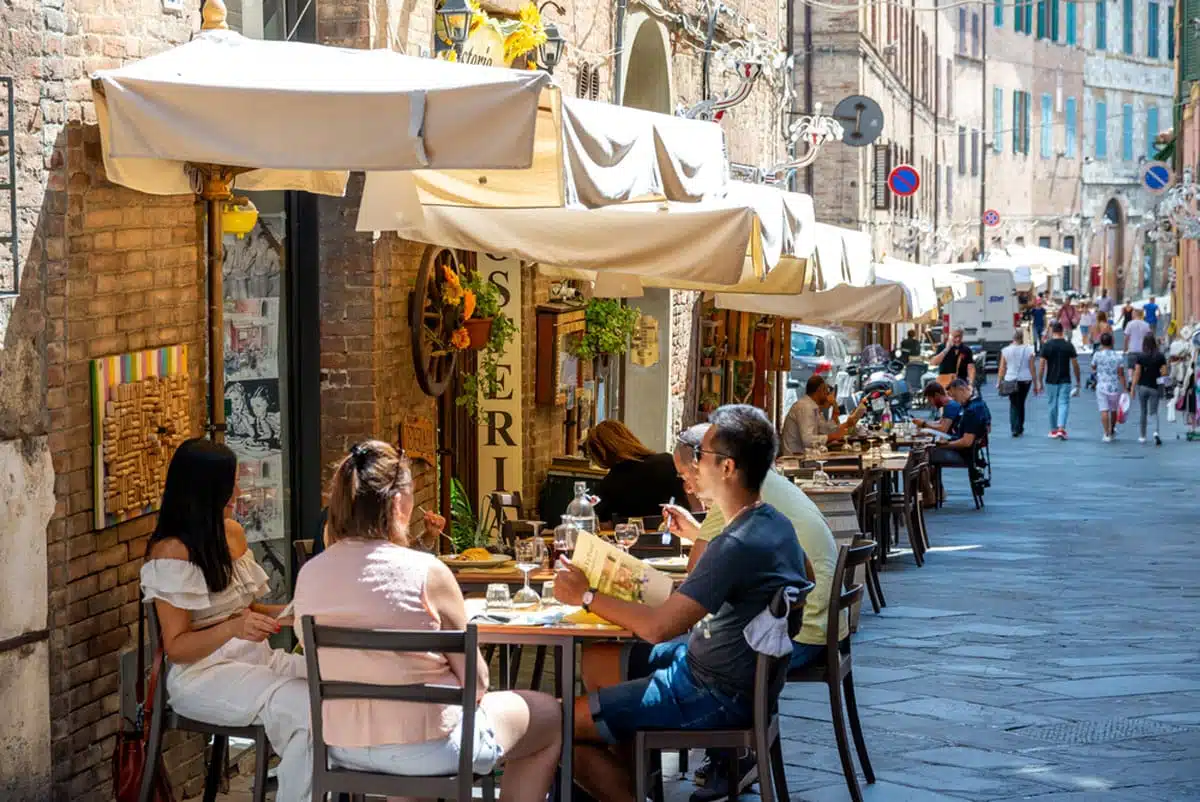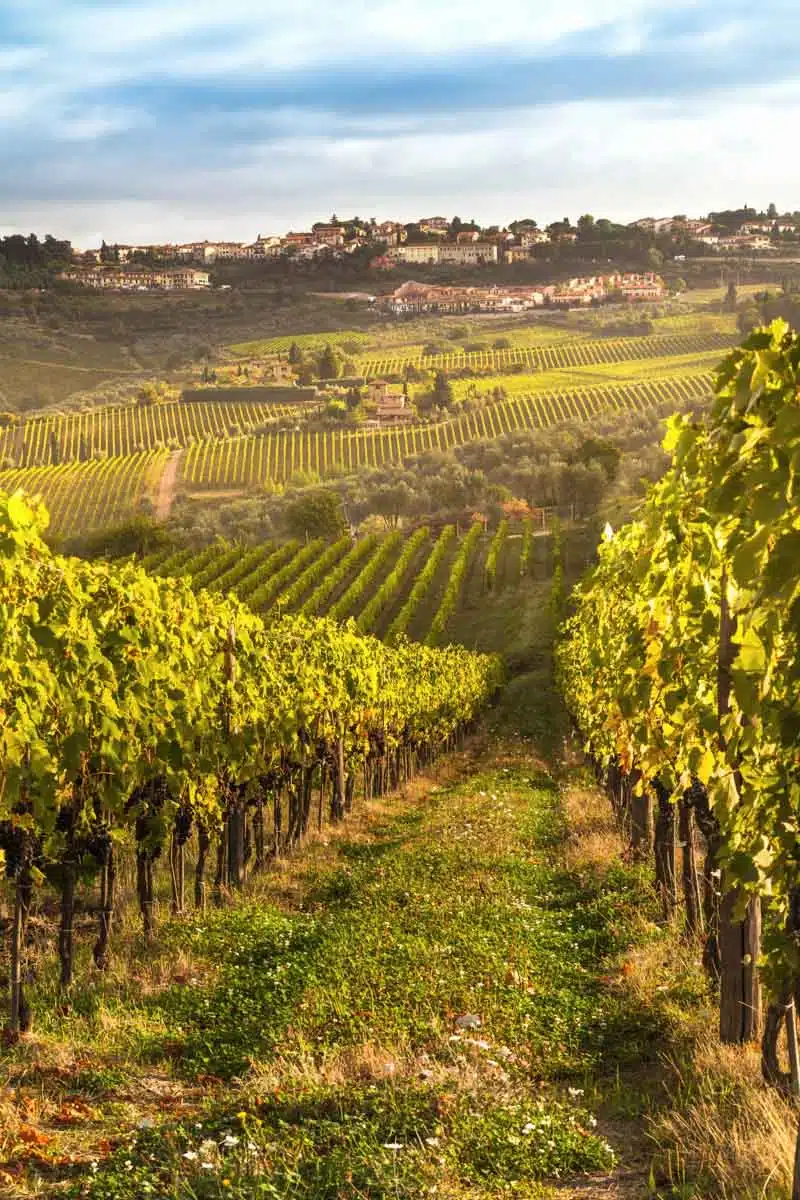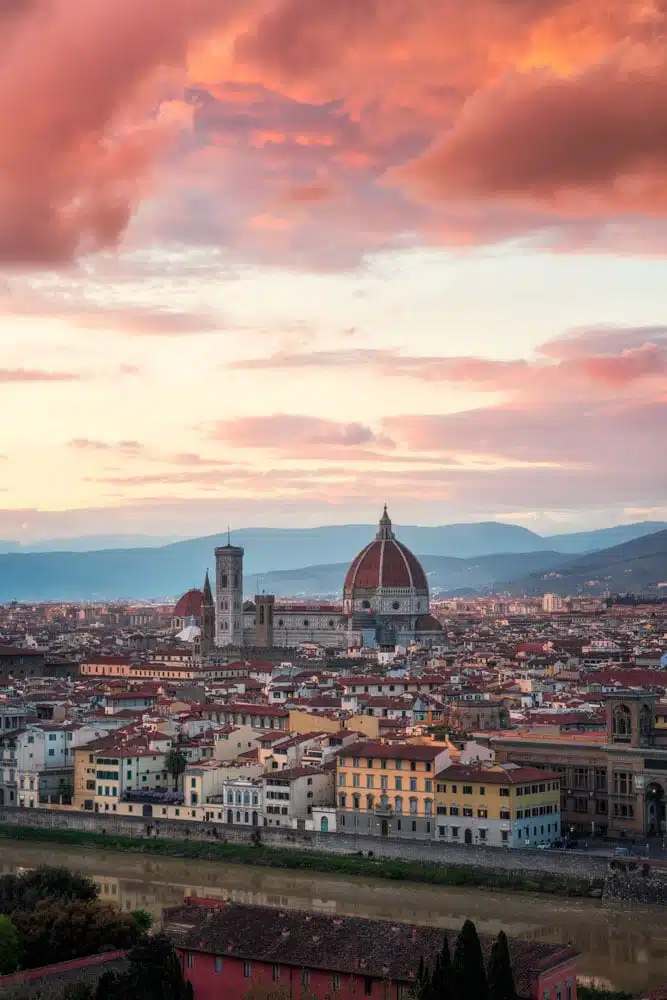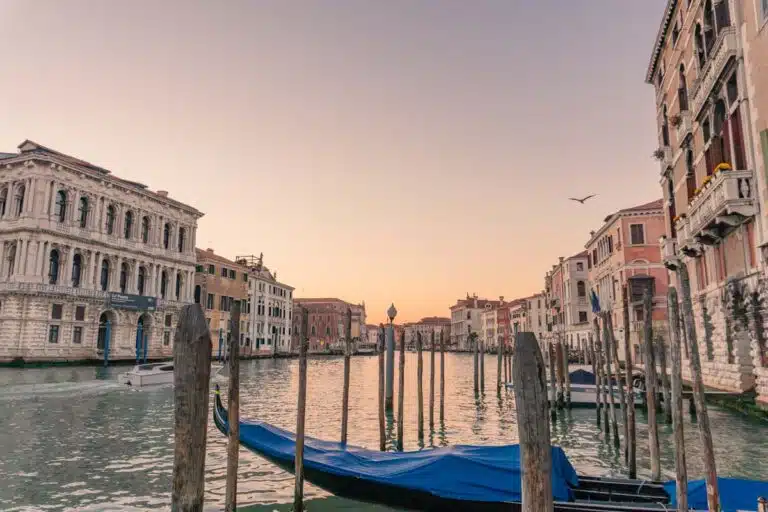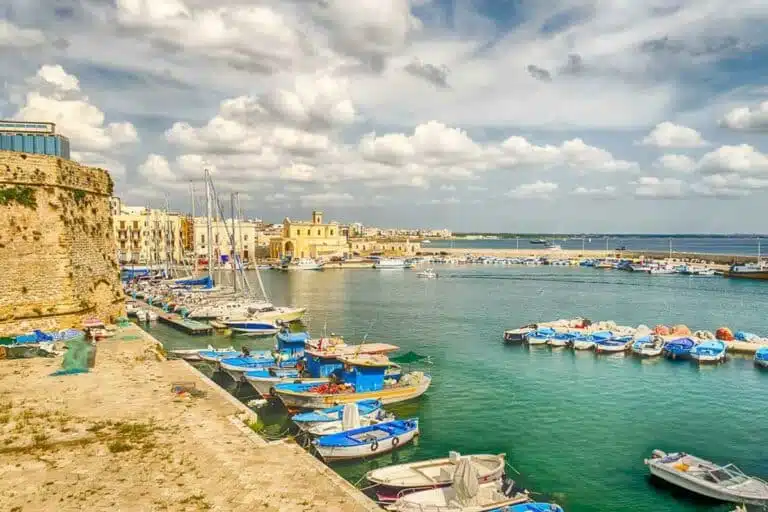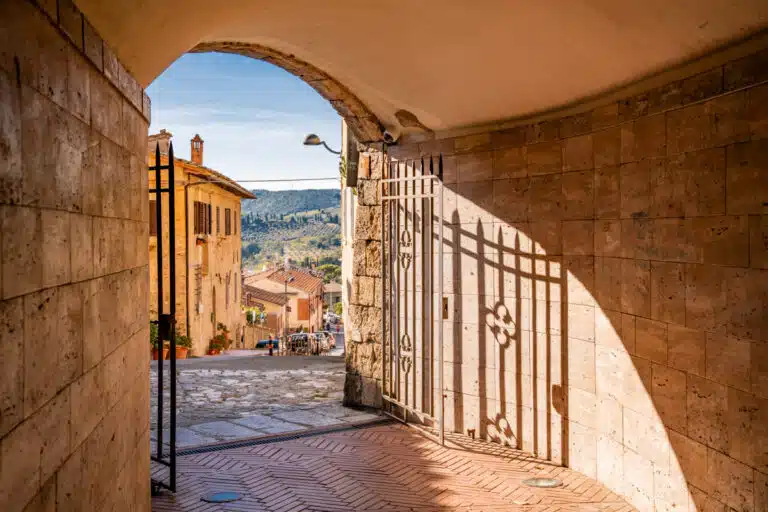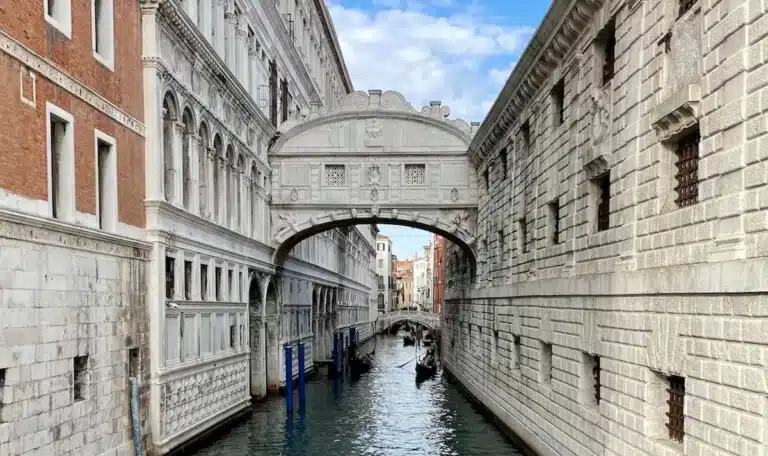Step into the cradle of the Renaissance – Florence. In a city where piazzas echoes with centuries of history, explore the majesty of the Duomo and the treasures of the Uffizi with this guide to the best things to do in Florence.
It’s no secret how much I love Tuscany – Italy’s fabled land of food and culture. Florence sits at the heart of it all, bursting with incredible architecture, art galleries and bustling food markets ready for you to discover.
It’s the kind of city you visit once and immediately start planning your return visit the moment you leave. Real talk: I think I prefer Florence to Rome. There’s something so mesmerising about this city that the Italian capital just cannot compete with (though, it comes pretty close).
Whether you’re spending two days or an entire week in the magical city of Florence, this guide will help you make the most out of your trip. You’re not going to see everything and that’s OK, but after reading this, you should come away with a good idea of exactly what you want to focus on.
So… Let’s fill that itinerary, shall we?
Best Things to Do in Florence
Visit The Cattedrale di Santa Maria del Fiore (Florence Duomo)
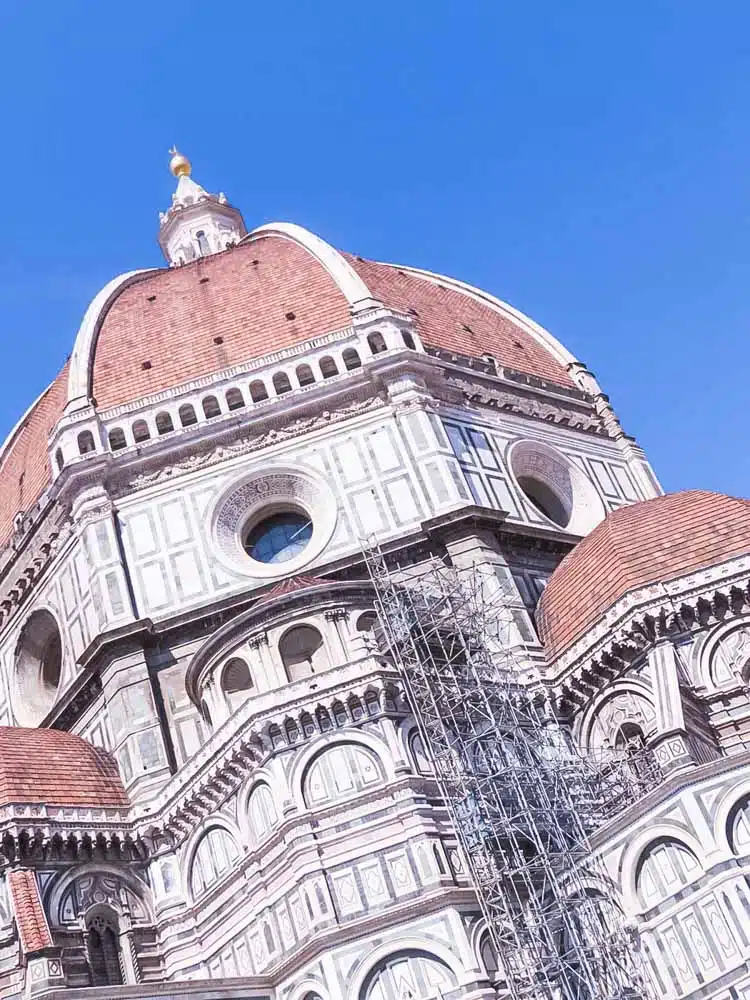
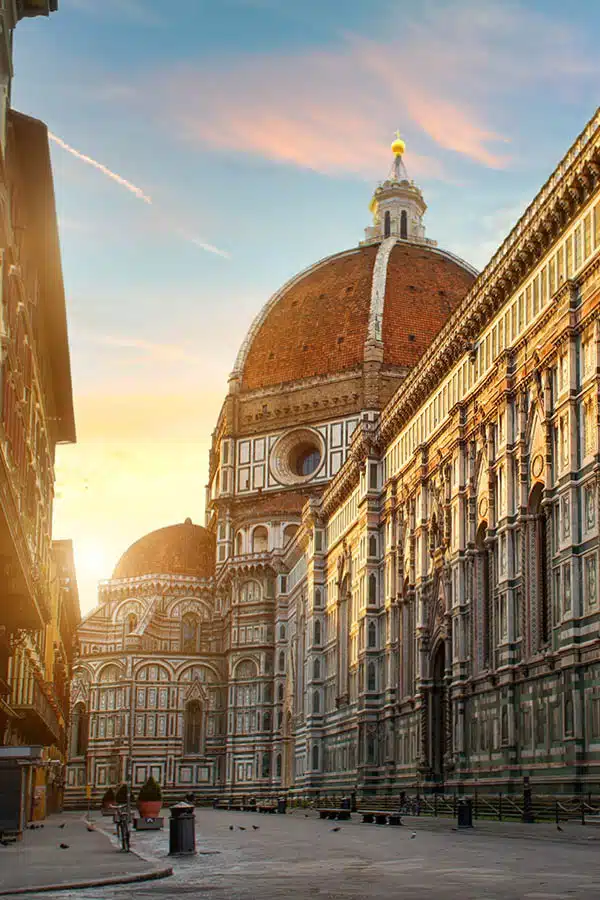
While the name the Cathedral of Saint Mary of the Flower might not necessarily ring a bell, I’ll bet that if I say Florence Duomo, you’ll know exactly what I’m talking about.
Florence is home to a constellation of architectural triumphs but none shine as brightly as its cathedral, known colloquially as the Duomo.
The impressive façade is decked out in white marble and red, pink, and green polychrome designs – the brainchild of Arnolfo di Cambio in the late 13th century.
Atop it all sits the Duomo’s crowning glory, Brunelleschi’s dome – a revolutionary piece of architecture and a stunning sight to behold. Ensure you nab a spot to climb the 463 steps to the top – it’s pretty much a rite of passage for anyone visiting the city.
During my first visit to Florence I’d come prepared for the striking exterior, but the interior really took me by surprise. It’s much more austere, but the roomy enclave holds more than its fair share of treasures – including the stunning Last Judgement fresco covering the dome’s underside.
If you want to delve even deeper, explore the rest of the complex, including the Baptistery and Giotto’s Campanile (both of which I’ve actually separate entries about later on in this guide). The Baptistery is one of the oldest buildings in Florence, while the Campanile offers some great views of Florence along with a compilation of religious sculptures and reliefs.
Do
Entrance to the cathedral is free but you have to pay for the dome, bell tower, Baptistery and museum. Alternatively, book onto a guided tour with entry tickets to the Duomo complex and a climb to the Cupola.
Explore Renaissance Art at The Uffizi Gallery
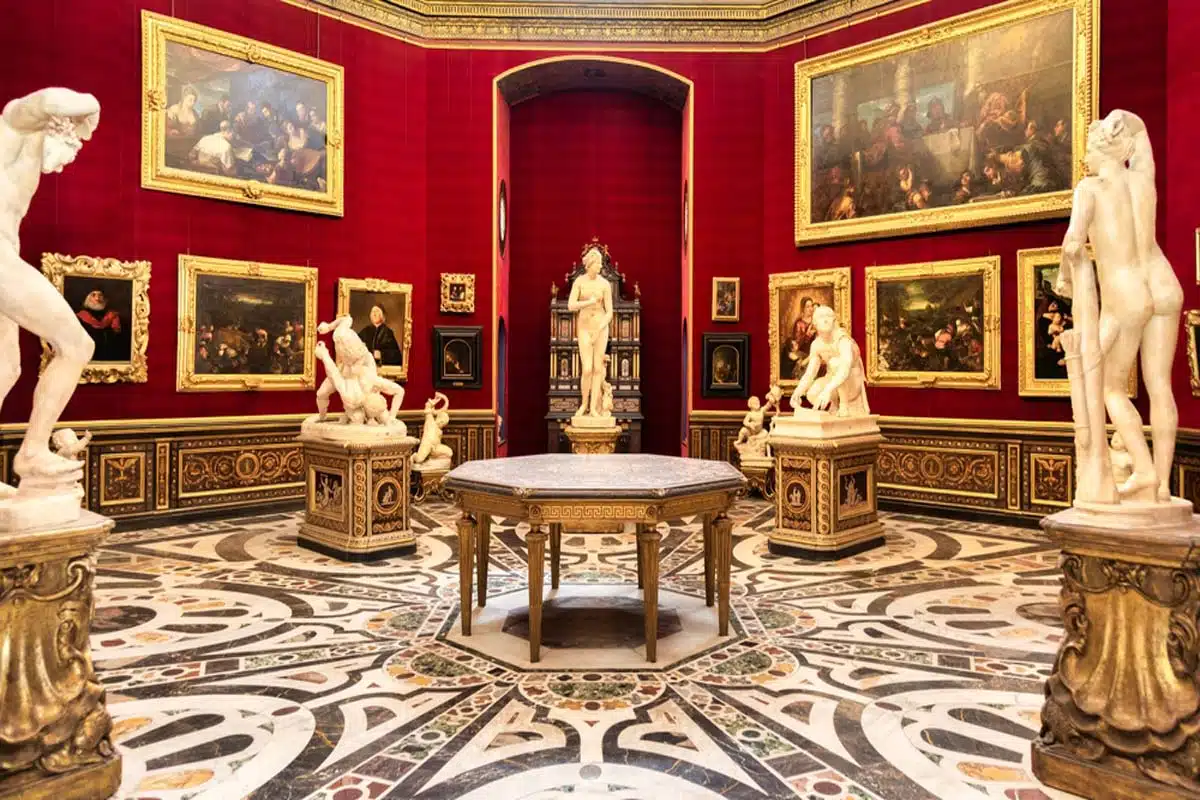
Hot on the heels of the Duomo in Florence’s list of most famous sights, the Uffizi Gallery is a treasure trove of Renaissance art.
Venture inside the horseshoe-shaped gallery to explore a world of artistic majesty including Botticelli’s The Birth of Venus – and that’s just the tip of the iceberg. The Uffuzi’s collection is a who’s who in art history – Boticelli, Michelangelo, Da Vinci, Carvaggio – the list goes on. In other words, set aside as much time as possible to explore.
While people skip from one big name to the next, my personal favourite gallery is the collection of self-portraits, which often goes unnoticed. Go to see a fascinating array of self-portraits from across the centuries.
The gallery itself is a stroke of genius. Built and designed by Italian painter Giorgio Vasari, its elegant extending colonnades, linear columns and pediments complement the artwork housed within. Don’t forget to take a peek out either – the views of the Arno and Ponte Vecchio are not to be missed.
Do
You can buy tickets on the door but queues tend to be frustratingly long. It’s best to get your skip-the-line entrance ticket in advance. You can thank me later.
Visit the Galleria dell’Accademia
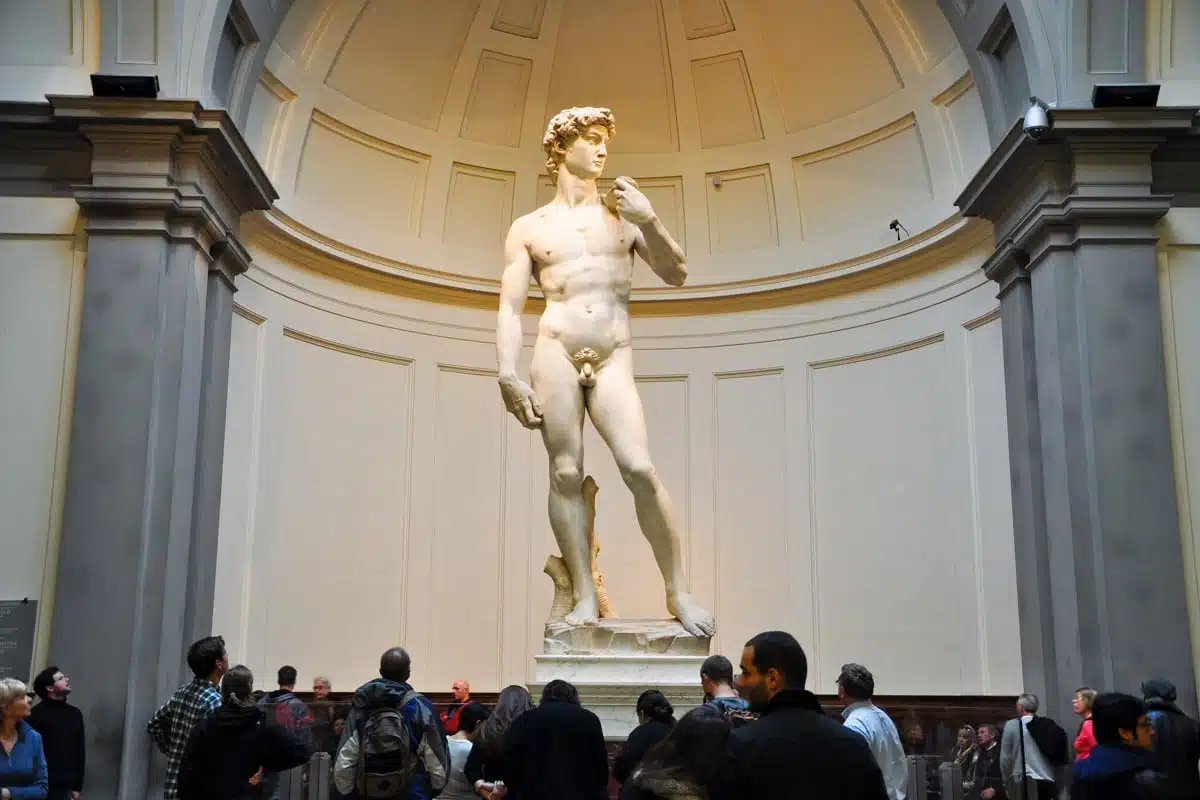
What even is the Galleria dell’Accademia? Without trying to oversell it, this is where you’ll see Michelangelo’s most famous works – of course I’m talking about David.
I won’t lie, you might get the impression that the entire gallery’s aim is solely to showcase David. I can’t blame it, though. He is quite an imposing sight.
A 26-year-old Michelangelo carved him out of a singular block of marble more than 500 years ago, creating a statue that embodies not just the biblical hero but also the essence of Renaissance thought in the human potential for beauty and perfection.
Perhaps it’s a bit unfair to narrow down the Accademia to just David alone – there’s also a wider collection of Gothic and Renaissance paintings that pay testament to the city’s historic art scene. For example, you can take a peek at other structures by Michaelangelo like Prisoners to see his artistic process at work. Or see works by Botticelli and Ghirlandaio.
Do
The museum is open 8.15am to 6.50pm. You can buy tickets on the door or get your reserved Accademia ticket to fast-track your way right in.
Ascend Giotto’s Campanile
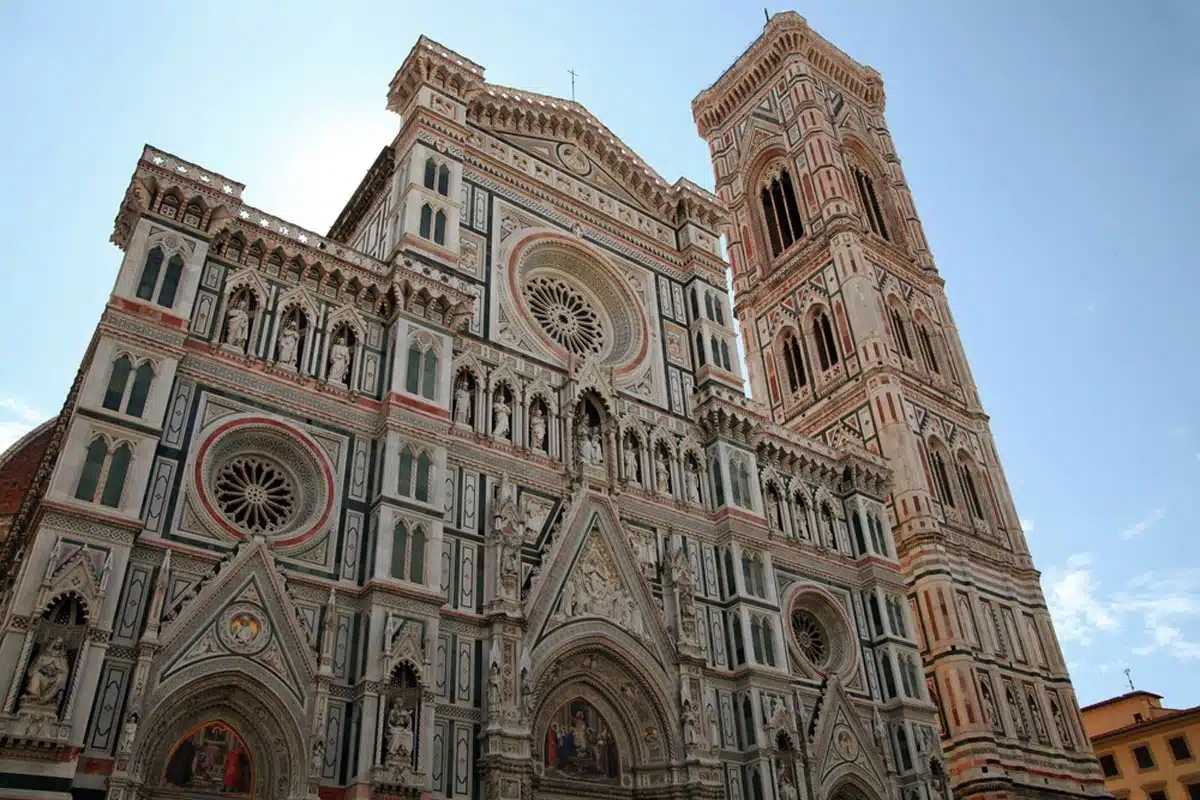
Some might tell you that Giotto’s Campanile sits directly connected to Duomo di Firenze, but it’s actually an entirely separate building and deserves a look in its own right.
A true masterpiece of Gothic architecture, the Campanile is one of the most renowned designs in the entire city.
Split across five unique levels, the exterior of the Campanile features the same polychrome designs the Duomo does. While construction started in 1334 by Giotto, Andrea Pisano and Francesco Talenti completed work on its upper levels after his death.
Inside, a world of art awaits, with a number of sculptures and reliefs narrating biblical stories on every level. There are depictions of the creation of man, and the arts and sciences that civilise him, works by Donatello and other pieces representing prophets and evangelists.
Sure, it’s a leg-scorching 414 steps to the top, but take comfort in the fact that each step offers a unique (and ever-better) view of the city spread out below and the Tuscan hills beyond.
Stroll Along the Ponte Vecchio
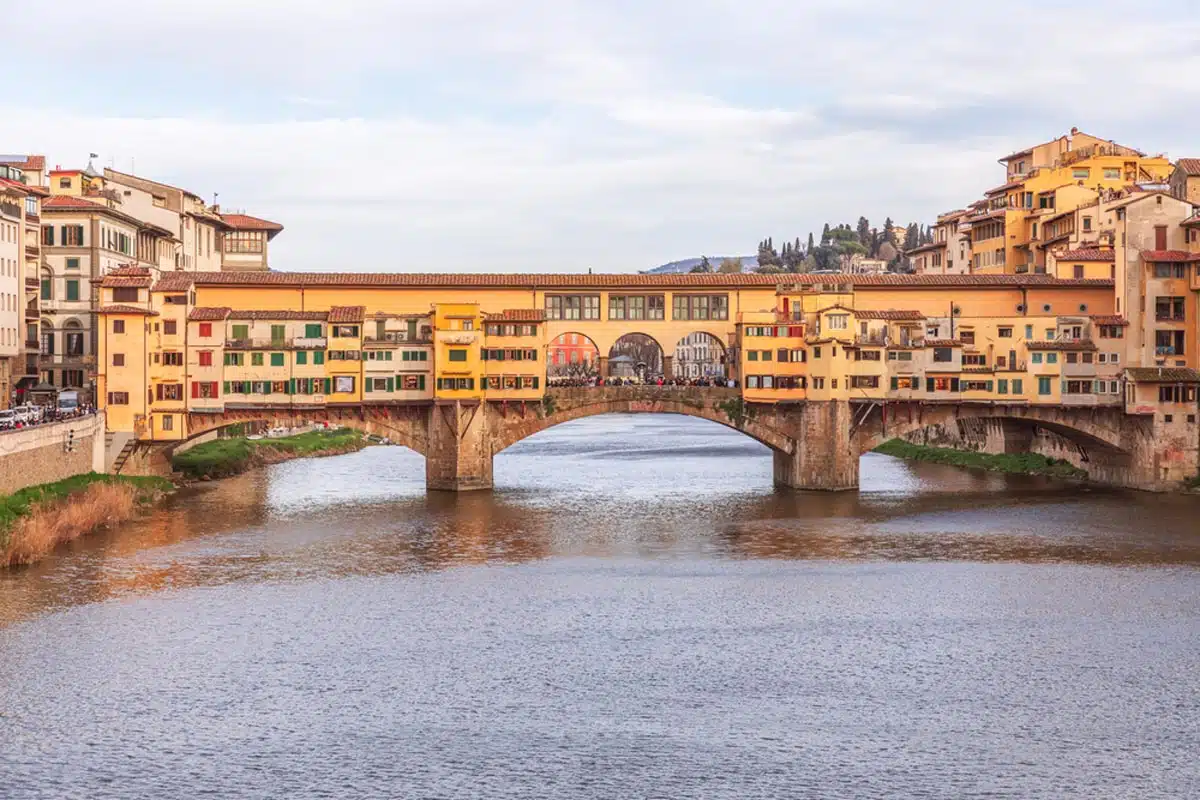
Okay, so the Ponte Vecchio is a staple of any visit to Florence.
What looks like a (rather whimsical) stone bridge arcing over the Arno River, is a living monument that has survived floods, wars and the brutal passage of time.
Lined with little shops and charming stalls that together create a whimsical market, it’s always been a hub of commerce – but did you know that before the jewellers and art dealers you see today, it was filled with butchers and bakers.
That all finished in 1593 when Ferdinando I decreed it should be transformed into a lane of luxury trades because he couldn’t stand the smell on one of the main walkways between the two sides of the city.
So that deals with the lower section of the Ponte Vecchio, but the more eagle-eyed among you will spy the smaller section on the top – that’s the Vasari Corridor, a secret passageway built for the Medici to move between the Palazzo Vecchio and the Palazzo Pitti.
Top Tip
The Vasari Corridor has been closed to visitors since 2016 but is due to reopen following renovations in May 2024. If you want to visit the Vasari Corridor you’ll need to buy a special ticket for the Uffuzi.
Appreciate the Beauty of Palazzo Vecchio
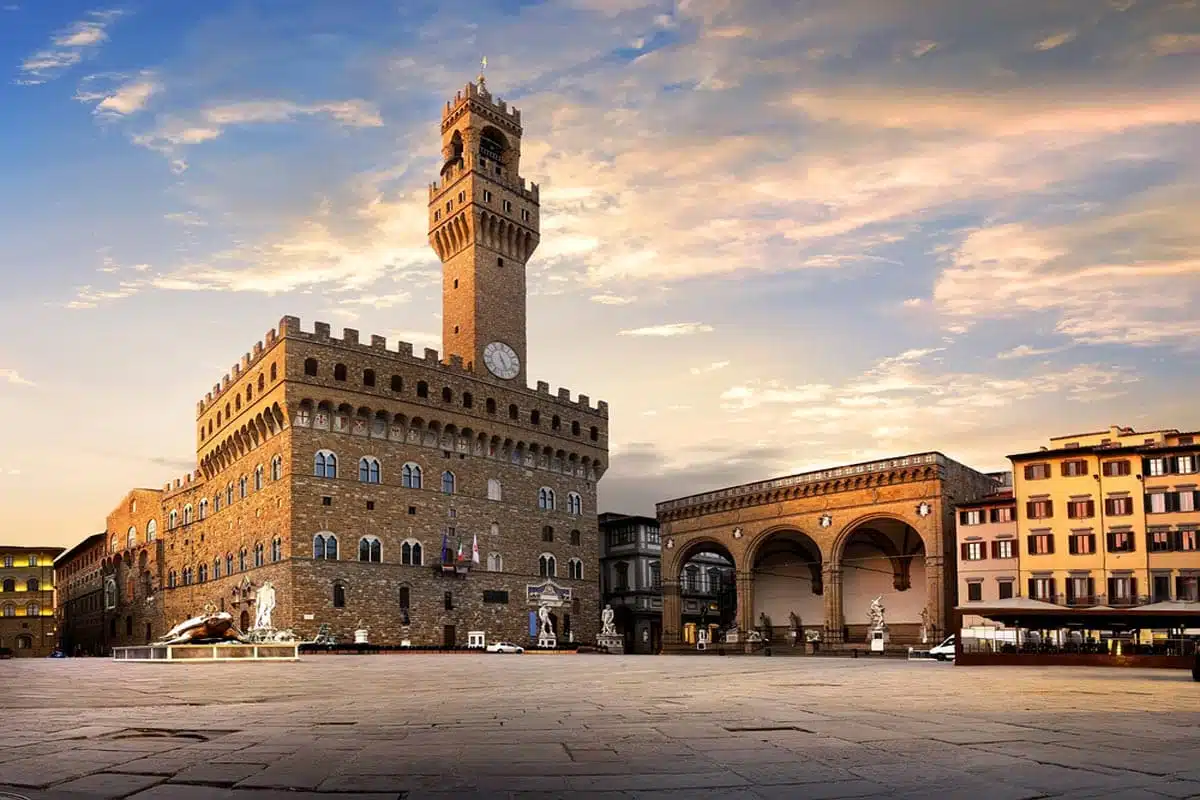
The Palazzo Vecchio is another must-see in Florence. While the Duomo is the city’s most religiously significant building, the Palazzo Vecchio is the city’s administrative centre standing tall on the Piazza della Signoria.
Designed by the same architect who worked on the Duomo and the church of Santa Croce, today it is a striking part of the Florentine landscape.
It resembles a castle, and its square design features a series of crenulations and a massive bell tower at the centre. But its the front façade that is truly impressive, with a coat of arms depicting various families of importance to Florence’s history.
Inside, you’ll find treasures such as the Salone dei Cinquecento, designed by Giorgio Vasari for Cosimo I – is a cavernous hall adorned with larger-than-life frescoes that extol the Medici’s virtues and victories.
It’s whispered that behind these very walls lies one of Florence’s greatest mysteries—the lost mural by Leonardo da Vinci, a tantalising enigma that adds an undercurrent of mystery to the hall’s grandeur.
For me, the highlight is the Arnolfo Tower – another tough climb that culminates in a panoramic view that stretches over Florence.
Discover the Basilica of Santa Croce
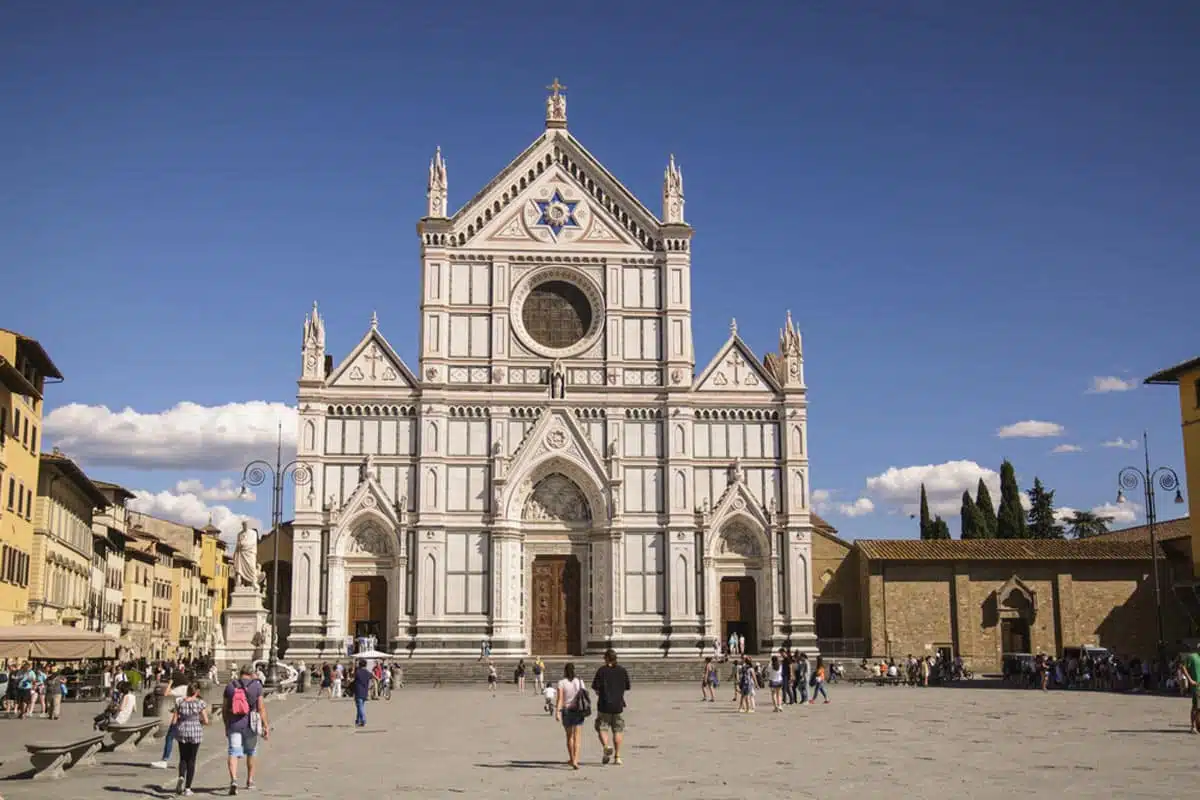
Sure, the Duomo di Firenze boasts size and importance, but an equally buzzworthy landmark albeit a bit smaller is the Basilica of Santa Croce. If you’re looking for an unforgettable Florence activity, opt for this Santa Croce church tour.
Framing the Piazza di Santa Croce, the basilica sees a similar construction to the Duomo, with pink, green, and red marble panels contrasting polished white stone. While there is a lot to see in the square, the basilica takes centre stage.
As enticing as the exterior is, once you step inside, you’ll quickly realise why this is such a famous attraction. It’s home to hundreds of tombs of the most influential Renaissance artists and scholars — some standouts include Galileo, Michelangelo, and Niccolo Machiavelli.
Catch a Sunset from the Piazzale Michelangelo
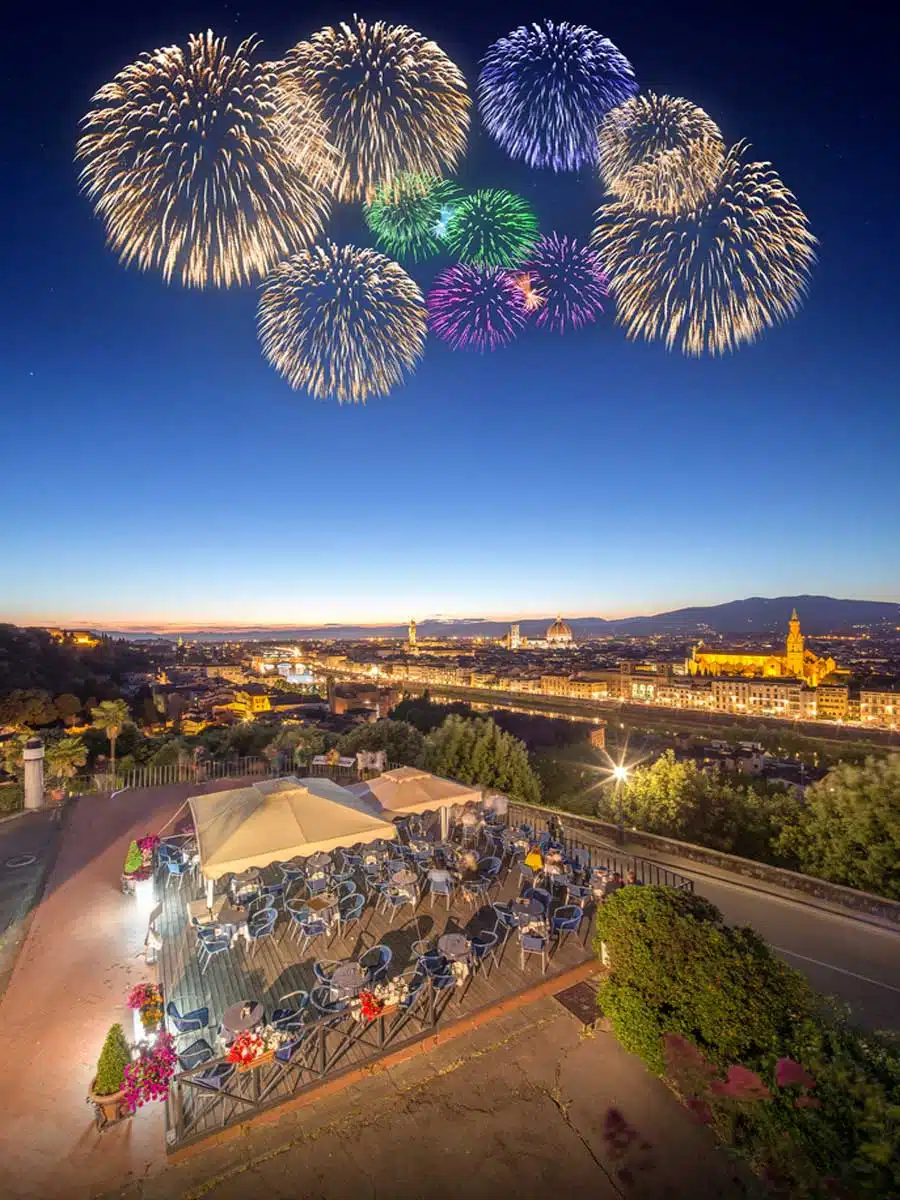
Perched atop the left bank of the Arno, the Piazzale Michelangelo is the place to go to get stunning views of the city. When I say stunning, I really mean it!
If I only recommend you do one thing in Florence beyond the biggest sights, it’s to go to Piazzale Michelangelo and catch an epic sunset. Immersing yourself in the golden glow of the sun setting over the city is almost surreal.
Arrive an hour or so before sundown as the area fills up quite quickly.
Getting There
You can either walk up on one of the many paths leading from the Arno River or go via a short bus ride on bus 12 or 13.
Visit the Baptistry of St. John
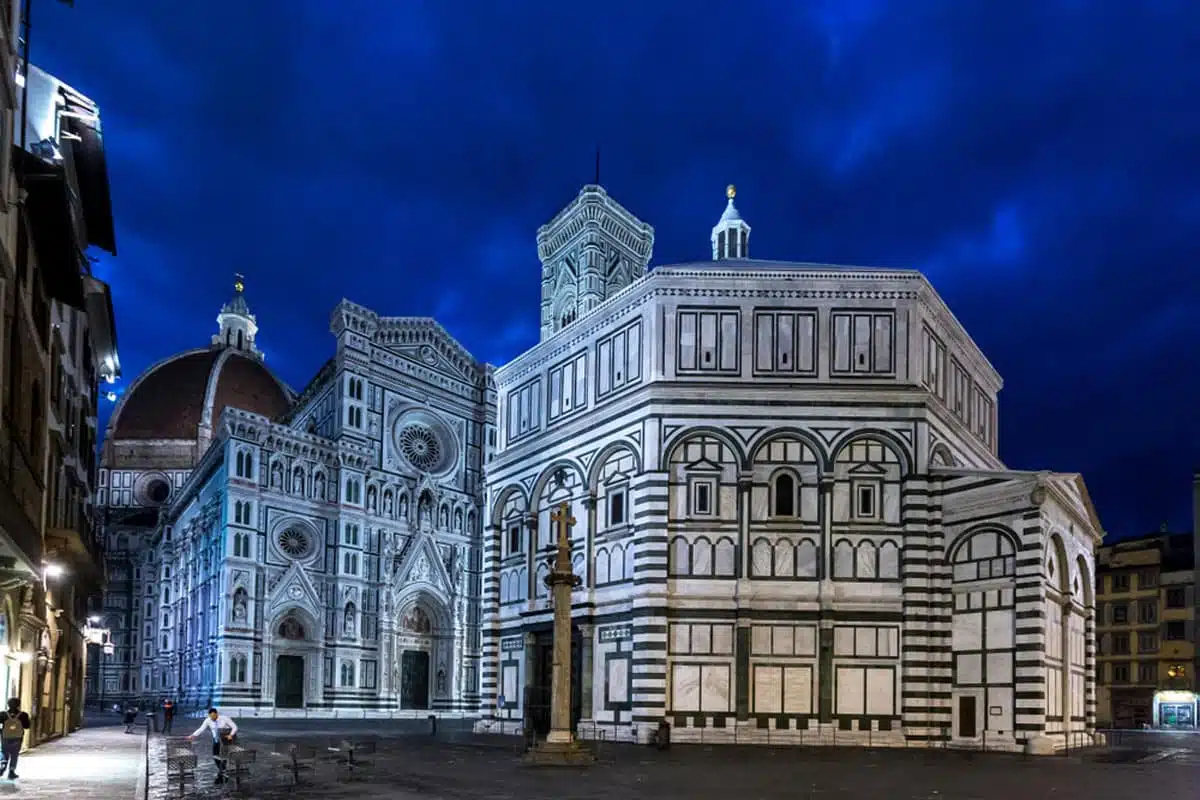
The final third of the trio of buildings that make up the so-called “Cathedral of Florence” is the Baptistry of St. John. Sitting in front of the main façade of the Duomo, this building stands alone as a separate building.
The exterior looks quite similar style-wise to the Duomo and the Campanile, and a lot of people skip it, assuming it doesn’t have anything new to offer. That’s a mistake.
It’s got charms and sights of its own: like the three sets of bronze doors on the exterior that depict numerous religious scenes and particular human virtues. Or the stunning Byzantine-style frescoes that cover the ceilings and walls inside.
Do
Unlike the Duomo, entrance to the Baptistery is not free and costs €4 ($ 4.30)
Delve Into History at the Basilica di San Lorenzo
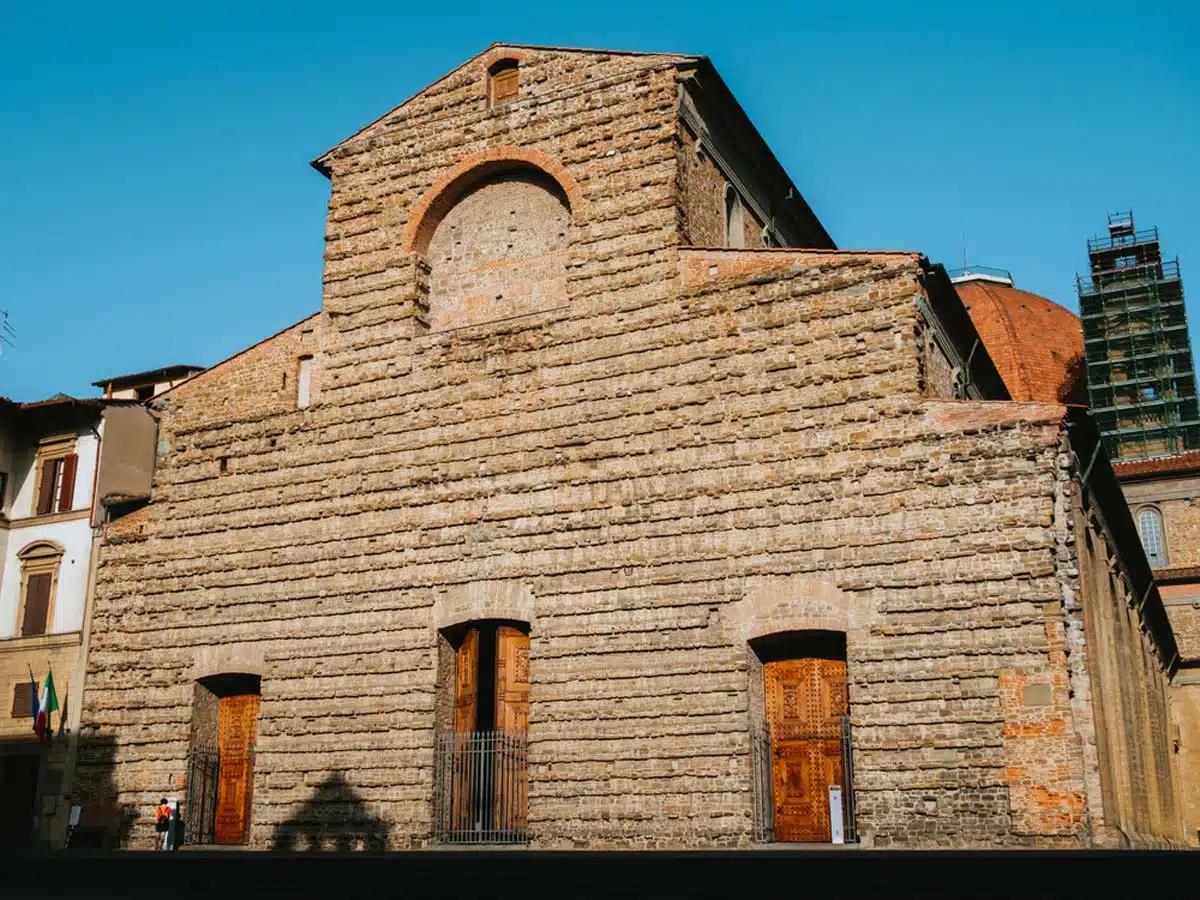
Just when you think you’ve had enough of historic churches, along comes the Basilica di San Lorenzo – a seemingly simple construction with a curious history.
Constructed under the rule of the Medici family that reigned over Florence for decades, it’s one of the city’s oldest churches and served as the family’s parish church during their rule.
Sure, it’s not as grand and ornamental as the Duomo, but its striking features – including a terracotta-tiled roof – make it well worth a visit.
Step inside and you’ll find a variety of artworks, a sacristy designed by Bruneschelli (yes, he of the Duomo’s dome fame), a library with a staircase designed by Michaleangelo and the opulent Chapel of the Princes, all underneath a gorgeous white and gold-gilded roof.
Top Tip
Keep an eye out for Michelangelo’s sculptures for the tombs of Lorenzo and Giuliano de’ Medici in the New Sacristy. These masterclasses in allegorical representation capture the tension between earthly power and the inexorable passage of time.
See The Historic Church of Santa Maria Novella
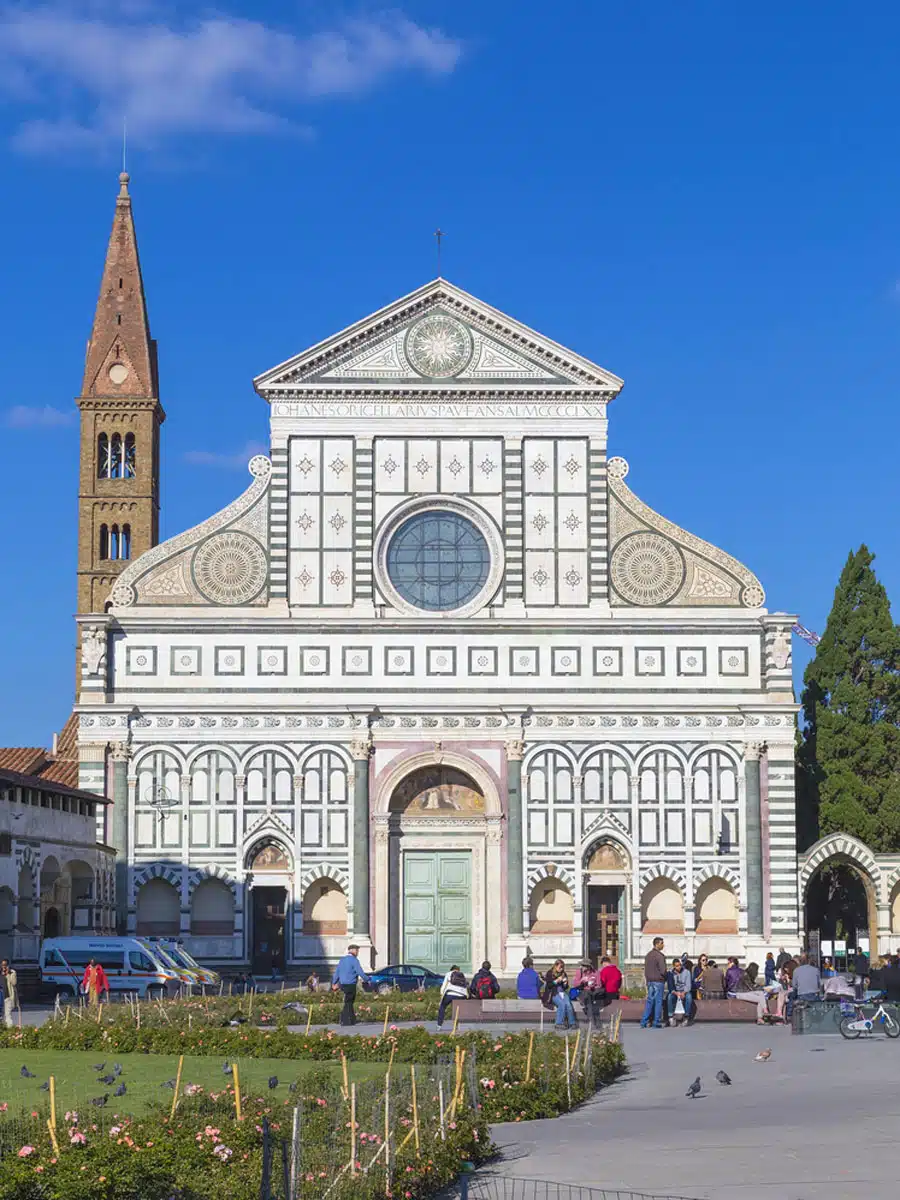
One of Florence’s great churches, the facade of Santa Maria Novella is a joyous mix of white and green marble that has echoes of the Duomo.
Inside, the church is full of important art from the 14th and 15th centuries including Masaccio’s Trinity, a painting that’s defined by its early use of perspective.
Head to the Tornabuoni Chapel, with its opulent frescoes by Ghirlandaio who depicts the lives of the Virgin Mary and St John the Baptist alongside (rather surprisingly) the everyday life of Florence’s citizens. Ecclesiastical art abounds in the city, but it’s much rarer to see the Florentine people of times past depicted in this way.
Aside from the main church, there’s a peaceful cloister known as the Green Cloister, home to frescoes by Paolo Uccello.
Explore the Boboli Gardens
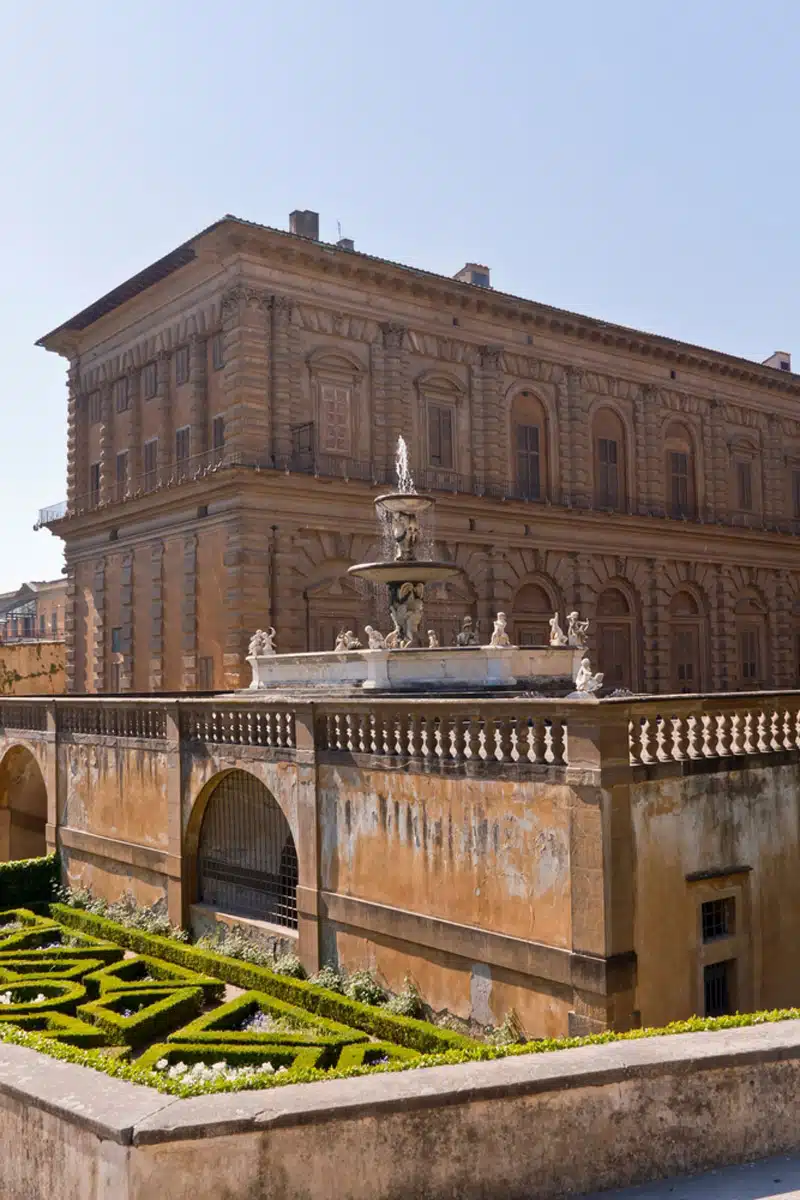
We’ve spent a lot of time inside – but this is Tuscany – a land of near-endless sunshine right?
Where better to pay tribute to that than the Boboli Gardens, a set of intricate gardens that were commissioned by the Medicis to match the splendour of the Palazzo Pitti.
The gardens are a grand example of Renaissance landscape design – originally masterminded in the 16th century by Niccoló Tribolo, they were later expanded by other architects including Giorgio Vasari and Bartlomeo Ammannati.
The Boboli Gardens are beautiful, but if I had to pick one place you shouldn’t miss, I’d say the Amphitheatre – an impressive open area with an Egyptian obelisk at its centre, surrounded by Roman and Renaissance statues. The area is still used for live performances now!
Top Tip
Climb higher in the gardens for lush views over Florence with the city’s rooftops and domes spread out before you.
Tuck into Some Bistecca Fiorentina
Bistecca alla Fiorentina, or Florentine steak, is not just a dish; it’s a culinary rite of passage!
The history of the dish dates back to the 16th century when English merchants would join the locals in feasting on grilled beef during the festival of San Lorenzo.
It’s traditionally cut from the Chianina cow – an ancient Tuscan breed that’s renowned for its flavourful but tender meat.
My personal favourite place to tuck into a bistecca fiorentina is the historic Trattoria Mario, which is just a short hop from the Mercato Centrale. It’s been serving up bistecca to locals since 1953 and has a no-frills decor that puts the focus front and centre on the meat.
Want to make a big deal out of your meal? Antica Macelleria Cecchini is another great spot, albeit in Panzano in Chianti. It’s run by famed butcher Dario Cecchini (whose restaurants you’ll find across Tuscany) and pretty much the go-to destination to feast on bistecca in the region.
Top Tip
Bistecca Fiorentina is traditionally cooked al sangue or rare. While you might get some flexibility on this, locals will definitely do a double take if you ask for it well-done.
Brancacci Chapel
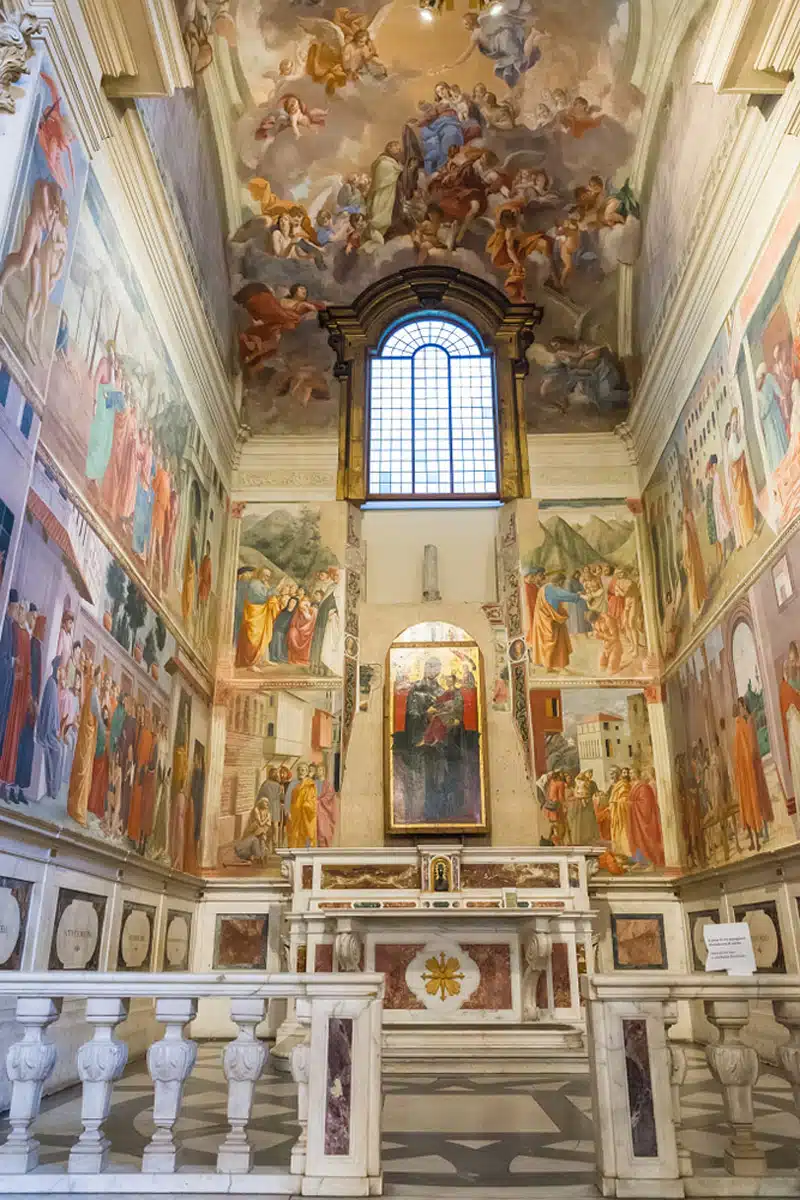
Nestled in the church of Santa Maria del Carmine, the Brancacci Chapel is one of the city’s lesser-known finds.
There’s really one big draw here and that’s the fresco cycle by Masaccio, Masolino, and Filippino Lippi, the chapel is often nicknamed the “Sistine Chapel of the Early Renaissance” thanks to the revolutionary artwork.
Masaccio’s contributions to the chapel, like The Tribute Money and The Expulsion from the Garden of Eden are famed for their emotional power and use of perspective, which were groundbreaking at the time of their creation in the 1420s. His mastery of light and shadow, along with the realistic depiction of figures, marked a new era of fresco painting that influenced countless artists after him.
Top Tip
The frescoes are currently being restored, but you can climb the scaffolding and see the restoration process up close on a special tour.
Explore the Bardini Gardens
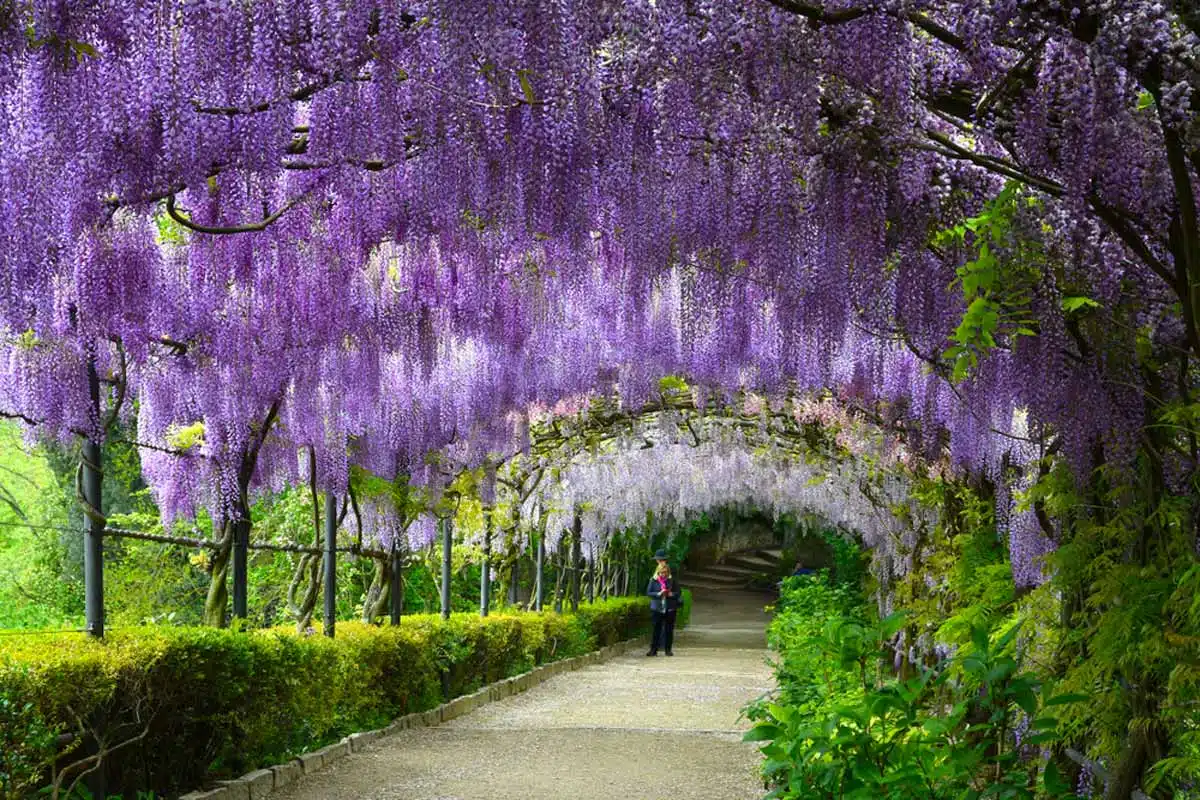
Not to be confused with the equally stunning Boboli Gardens featured above, the Bardini Gardens are a true hidden gem that features a captivatingly beautiful staircase visible from the Arno. If you’re looking to escape the crowds, this might just be the ticket.
Take a stroll through the olive grove for some genuine Tuscan vibes, or if you visit during April, grabbing a selfie or two underneath the blooming purple wisteria arch is a must.
So about that staircase – it’s a baroque-inspired masterpiece. Even better, there’s a charming little wine bar at the top!
Visit the Palazzo Pitti
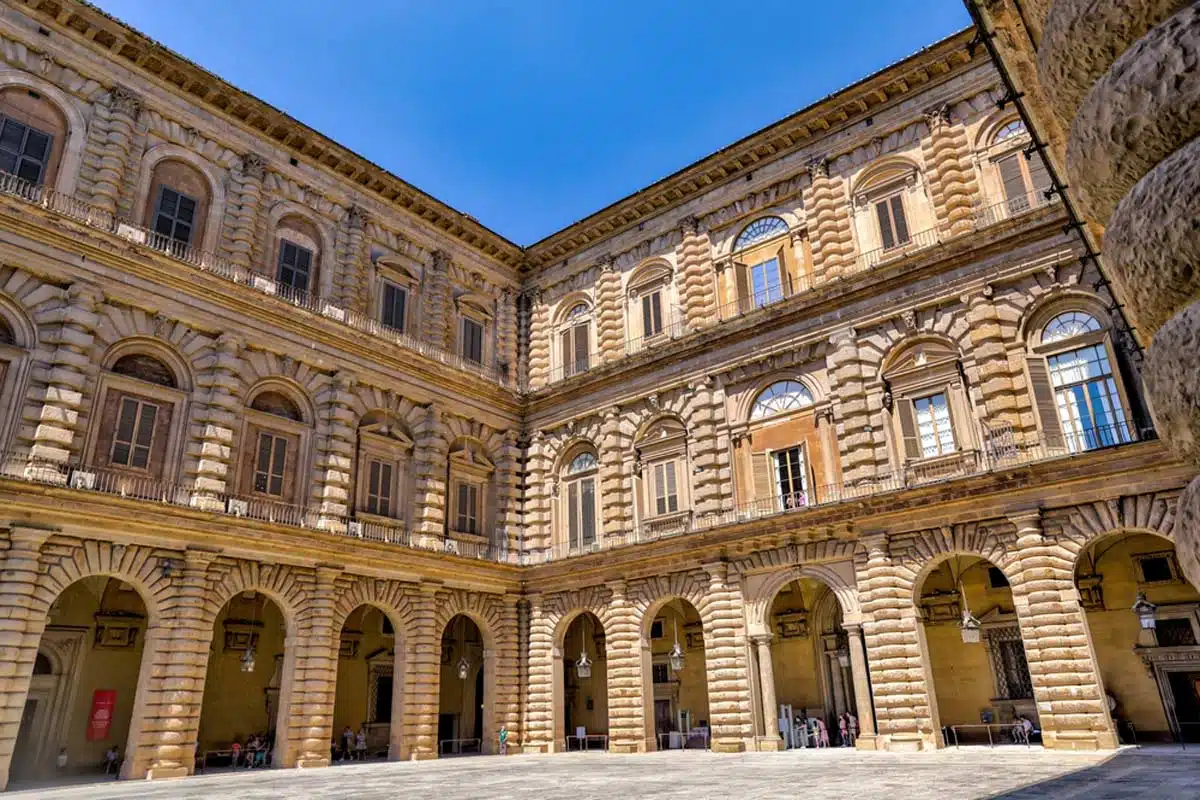
Standing on the southern banks of the Arno River, the Palazzo Pitti stuns with incredible Renaissance architecture from floor to ceiling. With its breathtaking grand square located at the front of the palace, which frames the front façade perfectly, visiting the palazzo is an absolute must.
Formerly the home of Italian royalty and power, the Pitti was also once the home of the high-flying Medici family. It now stands as the largest museum complex in the whole of Italy.
So what can you expect? A myriad of galleries and prominent sculptures.
Head into The Jupiter Room and marvel at some of the most impressive frescoes in the country and Raphael’s famous Veiled Lady.
Treat Yourself at Vivoli Gelato
What’s a trip to Italy without indulging in some expertly-made gelato? I’ll wait.
Vivoli Gelato is one of the oldest gelato shops in Florence, and might just be its best too.
Opening its doors in 1930, today, the shop bursts with flavour. Try the pistachio. And the stracciatella. And the lemon. You get the point.
Explore the Mercato Centrale
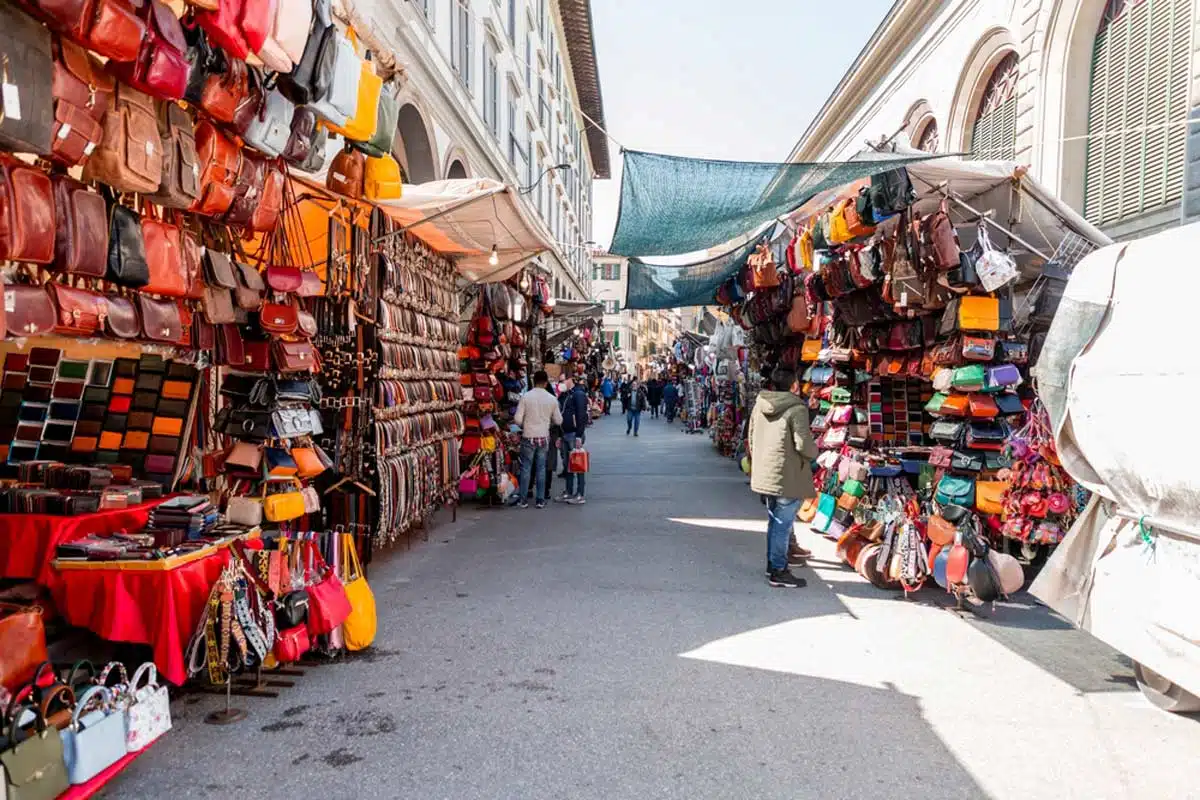
I hope you’re hungry! If you haven’t yet had your fill of Florentine cuisine and market life, head to the two-storey Mercato Centrale. It’s easily a must-do Florence activity that you won’t want to forget in a hurry.
This 19th-century venue plays host to vendors selling everything from wine and fruit to meat, fish, cheese, oils, and spices. But that’s just the ground floor.
Upstairs is an illustrious food court where many local eateries set up shop to treat your tastebuds. And when I say treat, I mean it.
Practical Tips for Your Florence Trip
Top Tips for Your Visit
- Skip the Line using a Firenze Card or book museum tickets online – this is particularly useful at the Uffuzi and Accademia where the lines can get very long.
- You’ll have to cover shoulders and knees to go into most churches – bring a scarf or shawl just in case.
- There are plenty of public drinking fountains with fresh water across Florence, so carry a reusable bottle to stay hydrated.
- Many shops and smaller museums do close for lunch between 1-3pm so plan your itinerary accordingly.
- You have to buy bus tickets before boarding at a tabaccheria or newsstand – they’re not sold on the buses and the fines for riding without a ticket can be steep.
- While credit cards are widely accepted, some smaller shops, markets and cab drivers still operate on a cash-only basis, so have some in your wallet.
How Long to Visit Florence?
Look, I’ll be honest: You can’t do Florence in one day. Many have tried and probably left feeling underwhelmed.
In this city filled with world-class museums, galleries, churches, and palaces, you should take two or three days as a minimum.
Best Time to Visit
The best time to visit Florence is between May and September when warmer weather sets in and the city comes alive with art festivals, open-air dining and a vibrant atmosphere.
Where Should I Stay in Florence?
Four Seasons Hotel Firenze
A lavish and extravagant property where opulence and tradition meet, the Four Seasons Hotel Firenze has no equal. Take your pick of lofty rooms that showcase the finest in styling and decor. And when you want to unwind, the gardens here are something magical.
Palazzo Montebello
If your budget is a little bit tighter, you can’t go wrong with the Palazzo Montebello. Rooms still feature finer touches, including spa baths and Egyptian cotton linen, while on-site, the Capriccio Restaurant serves up delicious Tuscan cuisine.
Recommended Tours
Things to Do in Florence: Map
Read More Florence Travel Guides
- 2 Days in Florence – A Step by Step Itinerary
- Where to Stay in Florence
- The Best Hotels in Florence
- Cool Day Trips from Florence
- What to Know Before You Visit Italy
- Italy in Winter Travel Guide
- An Epic Italy 10 Day Itinerary
Love This? Save and Share on Pinterest!
